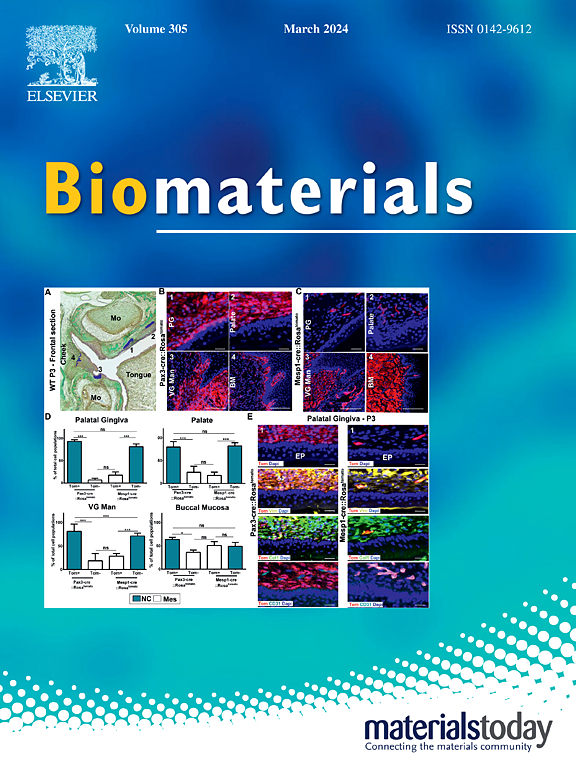Engineering pancreatic islet-loaded microfibers via pneumatically-controlled microfluidic spinning for the assembly of a microphysiological system
IF 12.8
1区 医学
Q1 ENGINEERING, BIOMEDICAL
引用次数: 0
Abstract
Microphysiological systems, including organ-on-a-chip systems, can achieve in vitro biomimicry of tissues and organs using microfluidic three-dimensional cell culture devices. These technologies can compensate for the shortcomings of animal models in basic disease research, and can even replace them in some cases. For example, they have demonstrated significant advantages and potential in the evaluation and screening of drugs for diabetes. In this study, we developed an islet microphysiological system based on a fibrous material and microfluidic spinning. This system includes pancreatic islet-loaded microfibers prepared using controllable pneumatic valves combined with microfluidic spinning technology and a microfluidic system comprising microfibers assembled with vascular endothelial cells. The results showed that the prepared microfibers loaded a large number of monodisperse pancreatic islet clusters with good cell activity and function. Microfibers were assembled with vascular endothelial cells in a microfluidic system, providing a 3D environment that mimicked natural blood vessels and supported high-throughput cell loading. Microfibers are vascularized by endothelial cells that grow on their surfaces. The microfluidic system simulated capillary blood flow and nutrient exchange, thereby enhancing the physiological relevance of the model. We evaluated the diabetes treatment drug Glucagon-like peptide-1 (GLP-1) using this system. Immunofluorescence staining, RT-qPCR, and ELISA confirmed the glucose-lowering and cardiovascular protective effects of GLP-1. This islet microphysiological system provides a novel platform for studying diabetes, screening new drugs, and promoting personalized medicine. The ability of this system to simulate physiological conditions through the synergy of biophysical and biochemical factors makes it a powerful tool for biomedical research.
利用气动控制的微流控纺丝技术制造装载胰岛的微纤维,以装配微生理系统
微生理系统,包括器官芯片系统,可以利用微流体三维细胞培养装置实现组织和器官的体外仿生。这些技术可以弥补动物模型在基础疾病研究中的不足,在某些情况下甚至可以取代动物模型。例如,它们在糖尿病药物的评估和筛选方面显示出显著的优势和潜力。在本研究中,我们开发了一种基于纤维材料和微流控纺丝的胰岛微生理系统。该系统包括利用可控气动阀结合微流控纺丝技术制备的胰岛负载微纤维和由血管内皮细胞组装的微纤维组成的微流控系统。结果表明,制备的微纤维承载了大量单分散的胰岛簇,具有良好的细胞活性和功能。微纤维与血管内皮细胞在微流体系统中组装,提供了一个模拟天然血管的3D环境,并支持高通量细胞负载。微纤维由生长在其表面的内皮细胞血管化。微流控系统模拟毛细血管血流和营养物质交换,从而增强了模型的生理相关性。我们使用该系统评估糖尿病治疗药物胰高血糖素样肽-1 (GLP-1)。免疫荧光染色、RT-qPCR和ELISA证实GLP-1具有降血糖和心血管保护作用。胰岛微生理系统为糖尿病研究、新药筛选、个体化治疗提供了新的平台。该系统通过生物物理和生化因素的协同作用来模拟生理条件的能力使其成为生物医学研究的有力工具。
本文章由计算机程序翻译,如有差异,请以英文原文为准。
求助全文
约1分钟内获得全文
求助全文
来源期刊

Biomaterials
工程技术-材料科学:生物材料
CiteScore
26.00
自引率
2.90%
发文量
565
审稿时长
46 days
期刊介绍:
Biomaterials is an international journal covering the science and clinical application of biomaterials. A biomaterial is now defined as a substance that has been engineered to take a form which, alone or as part of a complex system, is used to direct, by control of interactions with components of living systems, the course of any therapeutic or diagnostic procedure. It is the aim of the journal to provide a peer-reviewed forum for the publication of original papers and authoritative review and opinion papers dealing with the most important issues facing the use of biomaterials in clinical practice. The scope of the journal covers the wide range of physical, biological and chemical sciences that underpin the design of biomaterials and the clinical disciplines in which they are used. These sciences include polymer synthesis and characterization, drug and gene vector design, the biology of the host response, immunology and toxicology and self assembly at the nanoscale. Clinical applications include the therapies of medical technology and regenerative medicine in all clinical disciplines, and diagnostic systems that reply on innovative contrast and sensing agents. The journal is relevant to areas such as cancer diagnosis and therapy, implantable devices, drug delivery systems, gene vectors, bionanotechnology and tissue engineering.
 求助内容:
求助内容: 应助结果提醒方式:
应助结果提醒方式:


